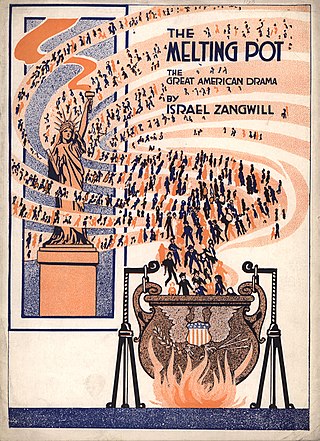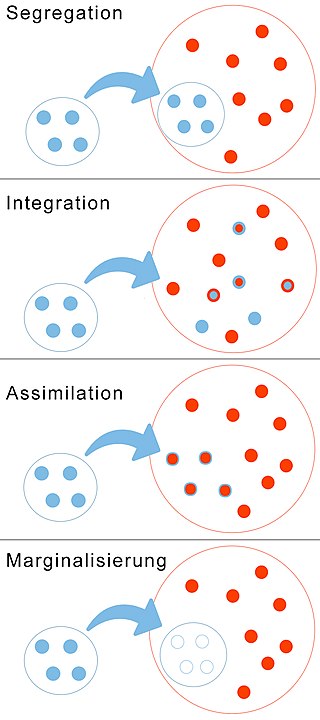
The term multiculturalism has a range of meanings within the contexts of sociology, political philosophy, and colloquial use. In sociology and in everyday usage, it is a synonym for "ethnic pluralism", with the two terms often used interchangeably, and for cultural pluralism in which various ethnic groups collaborate and enter into a dialogue with one another without having to sacrifice their particular identities. It can describe a mixed ethnic community area where multiple cultural traditions exist or a single country within which they do. Groups associated with an indigenous, aboriginal or autochthonous ethnic group and settler-descended ethnic groups are often the focus.

The melting pot is a monocultural metaphor for a heterogeneous society becoming more homogeneous, the different elements "melting together" with a common culture; an alternative being a homogeneous society becoming more heterogeneous through the influx of foreign elements with different cultural backgrounds, possessing the potential to create disharmony within the previous culture. It can also create a harmonious hybridized society known as cultural amalgamation. Historically, it is often used to describe the cultural integration of immigrants to the United States. A related concept has been defined as "cultural additivity."
The libertarian perspective on immigration is often regarded as one of the core concepts of libertarian theory and philosophy. There is considerable disagreement among libertarians as to what stance towards immigration best accords with libertarian principles. Some hold that restrictions on immigration are an infringement of the rights of immigrants and other property owners and constitute a threat to individual liberty. Others maintain that open borders amount to a policy of forced integration on the part of the state, and that protecting the rights of property holders requires that present governments adopt much more discriminatory policies on who is allowed to enter a country.

Acculturation is a process of social, psychological, and cultural change that stems from the balancing of two cultures while adapting to the prevailing culture of the society. Acculturation is a process in which an individual adopts, acquires and adjusts to a new cultural environment as a result of being placed into a new culture, or when another culture is brought to someone. Individuals of a differing culture try to incorporate themselves into the new more prevalent culture by participating in aspects of the more prevalent culture, such as their traditions, but still hold onto their original cultural values and traditions. The effects of acculturation can be seen at multiple levels in both the devotee of the prevailing culture and those who are assimilating into the culture.

Cultural identity is a part of a person's identity, or their self-conception and self-perception, and is related to nationality, ethnicity, religion, social class, generation, locality or any kind of social group that has its own distinct culture. In this way, cultural identity is both characteristic of the individual but also of the culturally identical group of members sharing the same cultural identity or upbringing. Cultural identity is a fluid process that is changed by different social, cultural, and historical experiences. Some people undergo more cultural identity changes as opposed to others, those who change less often have a clear cultural identity. This means that they have a dynamic yet stable integration of their culture.
Cultural assimilation is the process in which a minority group or culture comes to resemble a society's majority group or assume the values, behaviors, and beliefs of another group whether fully or partially.

In sociology, an ethnic enclave is a geographic area with high ethnic concentration, characteristic cultural identity, and economic activity. The term is usually used to refer to either a residential area or a workspace with a high concentration of ethnic firms. Their success and growth depends on self-sufficiency, and is coupled with economic prosperity.
Forced assimilation is an involuntary process of cultural assimilation of religious or ethnic minority groups during which they are forced to adopt language, national identity, norms, mores, customs, traditions, values, mentality, perceptions, way of life, and often religion and ideology of established and generally larger community belonging to dominant culture by government. Also enforcement of a new language in legislation, education, literature, worshiping counts as forced assimilation. Unlike ethnic cleansing, the local population is not outright destroyed and may or may not be forced to leave a certain area. Instead the assimilation of the population is made mandatory. This is also called mandatory assimilation by scholars who study genocide and nationalism. Mandatory assimilation has sometimes been made a policy of new or contested nations, often during or in the aftermath of a war. Some examples are both the German and French forced assimilation in the provinces Alsace and Lorraine, and some decades after the Swedish conquests of the Danish provinces Scania, Blekinge and Halland the local population was submitted to forced assimilation, or even the forced assimilation of ethnic Teochews in Bangkok by the Siam government during World War I until the 1973 uprising.
Cultural conservatism is described as the protection of the cultural heritage of a nation state, or of a culture not defined by state boundaries. It is usually associated with criticism of multiculturalism, and opposition to immigration. Cultural conservatism is sometimes concerned with the preservation of a language, such as French in Quebec, and other times with the preservation of an ethnic group's culture such as Native Americans.
Social integration is the process during which newcomers or minorities are incorporated into the social structure of the host society.

Americanization is the process of an immigrant to the United States becoming a person who shares American culture, values, beliefs, and customs by assimilating into the American nation. This process typically involves learning the American English language and adjusting to American culture, values, and customs.

An ethnoburb is a suburban residential and business area with a notable cluster of a particular ethnic minority population. Although the group may not constitute the majority within the region, it is a significant amount of the population. That can greatly influence the social geography within the area because of cultural and religious traditional values exhibited. Ethnoburbs allow for ethnic minority groups to maintain their individual identity, but that may also restrict their ability to fully assimilate into mainstream culture and society.
Integrative communication theory is a theory of cross-cultural adaptation proposed by Young Yun Kim. The first widely published version of Kim's theory is found in the last three chapters of a textbook authored by William Gudykunst with Young Yun Kim as second author. See acculturation and assimilation.
Criticism of multiculturalism questions the ideal of the maintenance of distinct ethnic cultures within a country. Multiculturalism is a particular subject of debate in certain European nations that are associated with the idea of a nation state. Critics of multiculturalism may argue against cultural integration of different ethnic and cultural groups to the existing laws and values of the country. Alternatively critics may argue for assimilation of different ethnic and cultural groups to a single national identity.

Multiculturalism in Canada was officially adopted by the government during the 1970s and 1980s. The Canadian federal government has been described as the instigator of multiculturalism as an ideology because of its public emphasis on the social importance of immigration. The 1960s Royal Commission on Bilingualism and Biculturalism is often referred to as the origin of modern political awareness of multiculturalism, resulting in Canada being one of the most multicultural nations in the world. The official state policy of multiculturalism is often cited as one of Canada's significant accomplishments, and a key distinguishing element of Canadian identity and Canadian values.
Multiculturalism in the Netherlands began with major increases in immigration during the 1950s and 1960s. As a consequence, an official national policy of multiculturalism was adopted in the early 1980s. This policy subsequently gave way to more assimilationist policies in the 1990s and post-electoral surveys uniformly showed from 1994 onwards that a majority preferred that immigrants assimilated rather than retained the culture of their country of origin. Even though the general acceptance of immigrants increased, opinion polls from the early 1980s and after showed that many were critical of immigration. Following the murders of Pim Fortuyn and Theo van Gogh the political debate on the role of multiculturalism in the Netherlands reached new heights.
Bicultural identity is the condition of being oneself regarding the combination of two cultures. The term can also be defined as biculturalism, which is the presence of two different cultures in the same country or region. As a general term, culture involves the behaviors and belief characteristics of a particular social, ethnic, or age group. Within culture, we have cultural effects, which are the shared behaviors and customs we learn from the institutions around us. An example of a cultural effect would be how an individual's personality is strongly influenced by the biological and social norms he is exposed to. Another cultural effect would be that in some societies it would be more acceptable to dress or act in a certain way.
Second-generation immigrants in the United States are individuals born and raised in the United States who have at least one foreign born parent. Although the term is an oxymoron which is often used ambiguously, this definition is cited by major research centers including the United States Census Bureau and the Pew Research Center.
John Widdup Berry is a psychologist known for his work in two areas: ecological and cultural influences on behavior; and the adaptation of immigrants and indigenous peoples following intercultural contact. The first is broadly in the domain of cross-cultural psychology; the second is in the domain of intercultural psychology.

The immigrant paradox in the United States is an observation that recent immigrants often outperform more established immigrants and non-immigrants on a number of health-, education-, and conduct- or crime-related outcomes, despite the numerous barriers they face to successful social integration.







